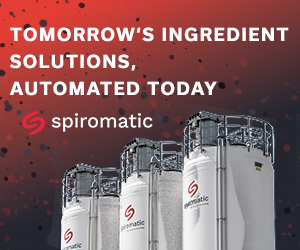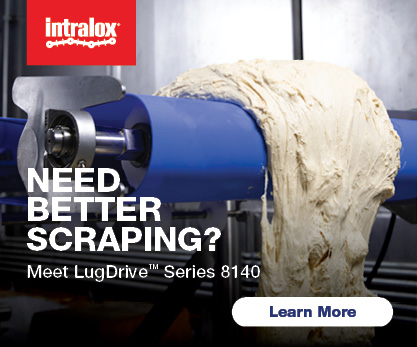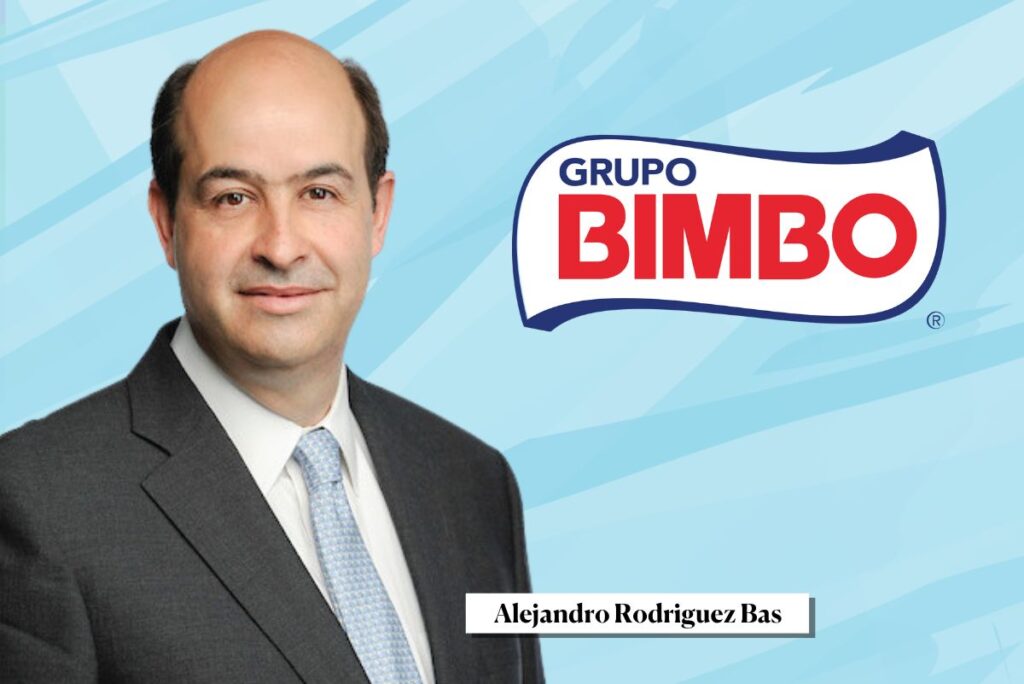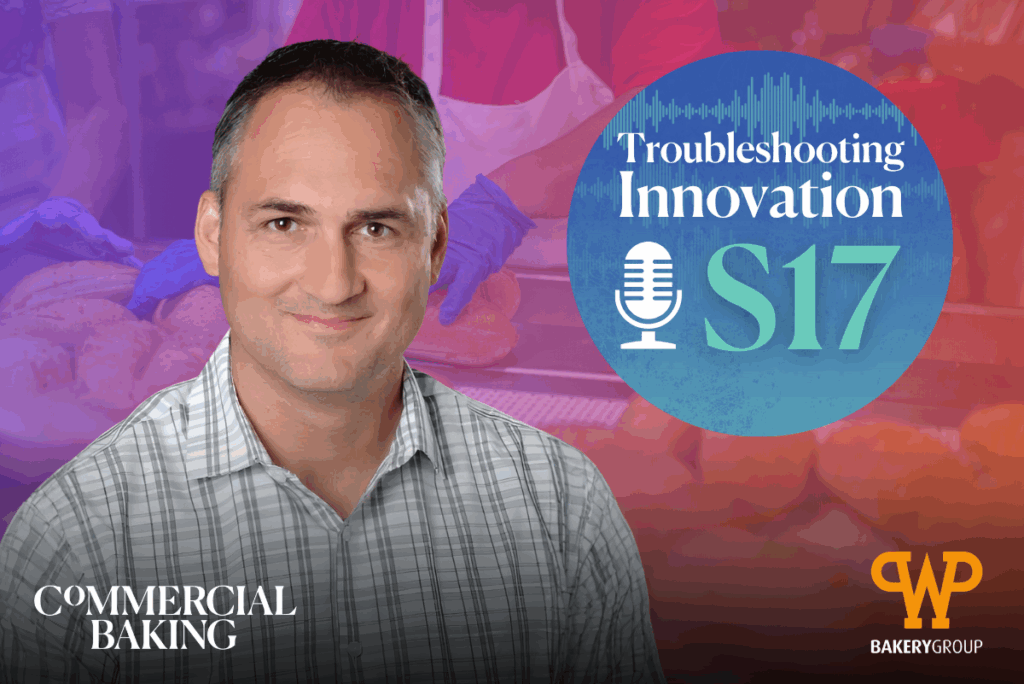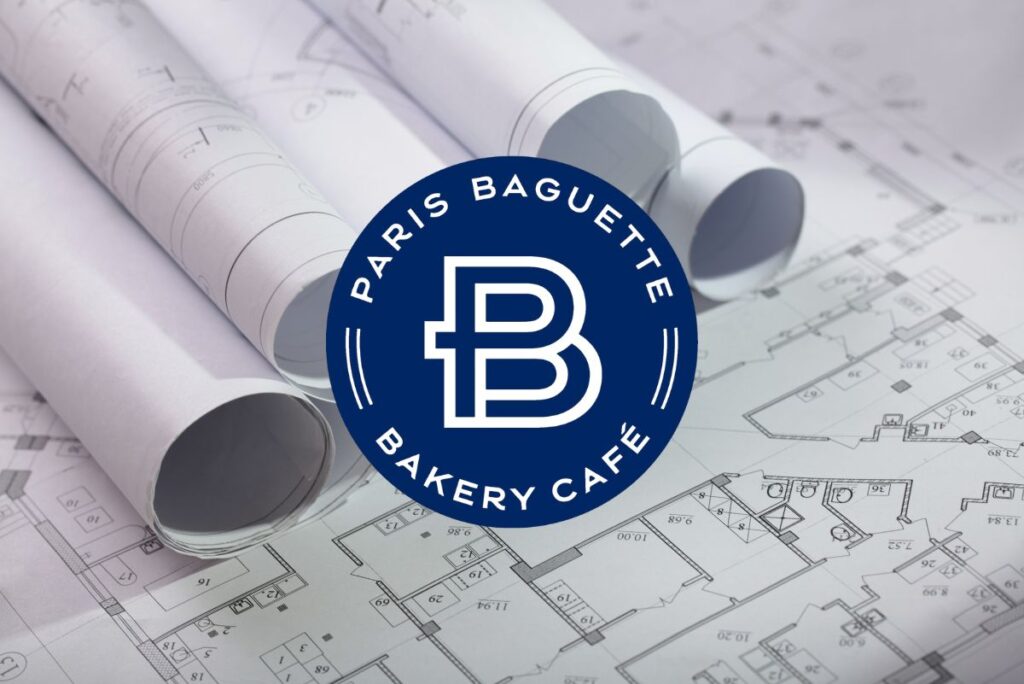Welcome to Season 16 of the Troubleshooting Innovation podcast. We’re spending this season with Dale Easdon, CEO of Klosterman Baking Co., to discover how this leader is carrying a legacy name into the industry’s future. Sponsored by Bundy Baking Solutions.
In our fifth and final episode, we dive into Dale’s vision for carrying on the Klosterman name.
Learn more about this season here, and tune into Troubleshooting Innovation on Apple or Spotify.
Joanie Spencer: Hi Dale. Thanks for these past four weeks. Thanks for joining me for the fifth and final episode. I’m sad to see it come to an end. This has been an incredible journey.
Dale Easdon: Yeah, well, thank you. I’ve enjoyed it as well. It’s been educational for me as well, and some good, challenging questions. So, thank you.
Spencer: Oh, thank you. Okay, so last week, and in previous episodes besides last week, we did talk about, you know, what it’s like stepping in to lead a formerly family-owned company. What kind of pressure comes with living up to a 130-year-old name?
Easdon: The first thing is, I really didn’t spend a lot of time with the families, because when the company was purchased, I came in about five months later. The family didn’t actually stay. So, the Klosterman family, when the private equity group purchased the company, they actually stepped out at that point — their choice — but they stepped out.
So, for me, actually when I joined, I didn’t have the history of the family, I didn’t know the family, and I also was new to the baking industry. So, I was going through my own learning curve, but it was a curve that I went through without having the Klosterman family around me. I got the pleasure of meeting Chip Klosterman; he came in to welcome me, which was extremely kind of him. So, I got a little bit of time, just a couple of hours with Chip.
But everybody I spoke to in the company, within the industry, obviously knew the family, and the family is very well-respected all around Cincinnati, Kentucky. They’ve just done, they’ve done a lot there. But me, personally, I actually never got to work with the family, so I really had to come in and work with the senior leadership team that I had here. And some of those great leaders have been here for a long time, you know, just our sales team had over 20 years seniority. So at least I had the great foundation to work with, and they were extremely patient with me whilst I was going through that learning curve.
But my view is simply the minute I take the job and put the hat on that says I’m the CEO, then I take full ownership of the company. And I was very quick then in getting into keeping everybody busy on building the vision, the mission statement, the strategy, the roadmap, and everybody just got so busy with that. I actually think they appreciated having a new leader with such a proven track record because they were also learning how to deal with private equity. And I was respected by the private equity group because we worked together a long time. So, they had done a great job of saying, you know, ‘Dale is really going to help. He’s going to roll his sleeves up and work with you.’
So, by the time we got together, I think we gelled pretty well. Actually, it was pretty fast, and we just got started. And the great — as I’ve said before in some of the episodes — having a great brand foundation is wonderful. I started with that. I wasn’t trying to build a brand. We have a brand, and the brand is something we’re very proud of.
Spencer: So okay, you’re in a new headquarters. How long have you been in that building?
Easdon: Just over one year. Yeah.
Spencer: Okay, so I’ve heard about the mural that is in the new headquarters. Can you tell me about that?
Easdon: Yeah! So, when we’re in the old headquarters, there was a room that had a lot of awards and plaques and trophies that we’ve gained over the years, and I had this thought of, ‘How can we do something that just respects the generations of Klosterman, and that’s something that’s really respectful for the industry?’ Just, you know, what can we do in the new headquarters? Because the new reception area, the new headquarters is absolutely beautiful. We’re really proud of it. And we spent over $2 million and built it out. And so, whilst I was walking around the city, again, my to learn my way about the city in the downtown area of Cincinnati, there are a number of local artists who paint some of the older buildings, but outside. So, they’ll do the whole side of the building. And some of these art pieces are 40 feet high, you know, they’re beautiful, and just some really gorgeous artwork.
So, I then got a team to see we could find a local artist. When we found this, this local artist who got introduced to me. He came in, and we took him for a tour of the bakery floor, and then we said we had this beautiful white wall that’s behind the reception desk. The best word to say is, it’s just a huge canvas. And I showed him the wall and said, ‘I want to cover this wall with an art piece that is completely dedicated to the baking industry, and I want the Klosterman logo on there, etc.’ And he said, ‘Yes, I can do that.’
So he went into the bakery and he made some videos, and he listened to the history. Amy sent him a lot of history from the company, and he came back with what he thought it would look like, and then we would make a couple of changes, and eventually clicked. And one thing I did see was I wanted really bright, vibrant colors for it. Anyway, he came in, in three weeks, he basically had a whole pulley system and painted this mural on the wall that is absolutely stunning. We posted it on LinkedIn. Now, anyone who visits gets their photograph taken with this painting, no matter who it is. We had one of our great customers came to visit us about four weeks ago. The whole team went out in front, said, ‘Let’s get a photograph with the painting.’ It’s just such a beautiful piece of art.
I did have to be a little bit subtle and hide something in the art piece. So, right dead center in this beautiful, dedicated painting to the bakery industry is a little Scottish flag. So, I had to get that put in there so that when I’m retired, living back up in the Highlands of Scotland, there’ll be a little Scottish flag. I’m sure when I leave Amy will change it to the American flag. But who cares? You know, it makes me feel good.
Spencer: It’s just like having your little fingerprint on it. I like it.
Easdon: Yeah, yes. But it’s something that I think was really, really dedicated to the industry, and it’s just a nice talking point. I shared it with Eric and the guys at ABA. They just thought it was wonderful. So we’re very proud of it.
Spencer: And it’s large. I think the photos don’t do it justice. It’s pretty tall.
Easdon: So what he actually did was he came in one weekend, and he was coming in every night. He only worked at night, so during the day, we would run reception, and then he’d come in and all the furniture would be removed, and he would start. But the first weekend, I came in, on the Monday, and the full wall was covered in graffiti. And I mean, total graffiti all over the wall. And it was quite fun what he’d written, but he’d written things about the industry and things about me, and you know, Scotland, the Brave and freedom — all these things all over the wall — so much so that one of the supervisors from the bakery, because below our headquarters is our largest bakery, and one of the supervisors came out and seen it and thought someone had done this as graffiti.
Spencer: Like somebody broke in.
Easdon: Yes. And he was really upset. He was calling the general manager. And what it actually was, which was amazing to me, it’s a grid system.
So, the artist uses the graffiti as a grid because of the scale of the painting is so large, that he uses each part of the graffiti was the grid to do the painting. So, it almost looked like a painting by numbers. Over the weeks, you could see it starting to come in, and when it finished, it was exactly what he showed us on the scale of the wall. So, it was a very, very interesting project, and everybody was watching it, so we all got to see it every day. And so, the good thing about it is we were going to put up shelves and put up a walls, and then how we going to clean them, and how do we get to them? And nobody will ever look at them. So, I think this way, when someone walks in the front door, the first thing they see is this beautiful painting, and they’re normally outside in buildings. This one’s inside. And I think it’s a beautiful touch.
Spencer: So cool, so cool. Okay, so I want to talk about the Klosterman products for a few minutes. Bread in several different formats is really Klosterman’s core product. And I’m sure that you had this working in prepared foods and foodservice. Yes, there is this on again, off again relationship that consumers have with bread. So, when you think about that on again, off again, what would you say now that you’re leading a bread manufacturing company, what is the trick to staying relevant with a product that goes in and out of fashion depending on whatever consumer opinion is being swayed?
Easdon: Yeah, well, I think, I think the first thing is there’s different types of bread, I believe, for different stages of life. And what I mean by that is, you know, when I grew up with my mum and dad and five kids, my mum was just trying to keep seven of us fed, so there was always bread on the table. And I think a loaf disappeared on every meal. So, we never had time to worry about what, you know, was a sugar content, or was it high protein, or was it, it was just bread.
And I think that still exists. So, there are families out there just want a nice, fresh, wholesome loaf. And we do that. We do an amazing job. And we fed generations with Klosterman’s bread. You know, we talk about, you know, half loaves. We talk about creating rye bread, some of the products. But what I can tell you is, we listen to our customers.
So, one of our largest customers that we have is actually in the development stages with us right now, and we’re getting ready early next year to launch a new high-protein bread. Not to be confused with, you know, some of these keto breads that just don’t have the flavor profile. This is just a beautiful, amazing loaf that we’re working together to launch, and I’m excited about it. I think it’s going to sell off the shelves. I think it’s going to be just a great product. So you’ve just got to be continually listening to your customer and working on development.
We have a great development team here. Our master baker Kyle is just fantastic, and he works closely with a customer. So just that for us is something that we get excited about. As you know, we also have, you know, high volume in buns, and making sure that we have those beautiful buns. And then we have our partnership with Sixteen Bricks, which I mentioned earlier in one of the episodes, which is one of the best artisan breads that you’ll ever taste. And Ryan, who is the owner and founder of the company in Cincinnati, he wins, I think he’s on year five of being the top baker in Cincinnati, and all the top restaurants use his product. So, we have his artisan bread, and we have a three-year contract. We buy 60% of all of his volume, and we sell that through some of our fresh and frozen stream.
And then hot off the press, the latest is we have just created a new brand of donuts. So, we’re launching four new donuts through DOT distribution, and about four weeks ago, we shipped our first pallet of our own. So, we produce donuts for one of our large customers, and that’s the only customer we made donuts for. These are cake mix so they actually freeze, so we can ship them across the country. And we created four new donuts for one, new packaging with a new box. And we’ve launched, and there’s been a quite an interesting uptake, and we’re starting getting, I think there’s about 24 to 25 customers asking us about these products. So, I’m excited to be able to really launch the donut business as well. We only make donuts in one bakery. We have a dedicated line, and again, we only make cake mix donuts, not yeast-based and there’s been really, really positive feedback with these donuts, so I’m excited about that.
Spencer: That’s awesome. Did it have any sort of impact on the workforce? Did you have to bring in new workers for that donut line, or were you able to cross-train in that bakery?
Easdon: What we actually did is we got into donuts about six years ago, and one of our largest customers, asked us to dedicate a line for donuts. So, we brought over and brought in a new expert in donuts who’d been with us for five years. He just retired at Christmas, and a great specialist, just a wonderful individual. He retired, but also gave us his back fill, someone he developed so that we have an expert there. So, we’d been making donuts, but when we renewed our contract with the customer, we put in the contract we’d like to take some of the capacity of the donut line and develop our own donuts and sell them, to which the customer was absolutely fine. Because if we sell more donuts, it reduces the overhead to the customer, so they’re happy as well. So, it’s win, win. We had about 45% capacity on our donut line, so we then decided to create our own. And the goal here is to just simply run a full night shift, another shift to make our own donuts and take that volume out, and I would believe within two years, we will have sold all of that capacity.
Spencer: Wow. Okay, that’s really interesting and very strategic. And I’ve been hearing a little bit about that out in the industry from other bakers too, that when you can pick up more business, it lowers that overhead for the customer, and actually makes it better for the customer when you’re picking up more business,
Easdon: Yes, absolutely.
Spencer: Okay, I have, like, a more marketing-related question, and I want to just confirm that I that I am correct that Klosterman serves foodservice customers as well as your branded products that you sell on store shelves, correct?
Easdon: That is correct.
Spencer: Okay, so I’m curious, in this context of carrying on this 130-year-old name, are there marketing challenges that come with managing both types of business? I guess the reason why I’m thinking about it is consumers now have access to so much information that they’ve got the backstory on everything that’s on a restaurant menu, like they can access all of it, and they just want to know. So usually, a bakery that supplies restaurants, they’re just behind the scenes, and they don’t really have a brand. They just have their product and their reputation. But in modern day marketing, like, what are the challenges that come with that, and is there benefit to being a known brand? So, like, re there menus that say featuring Klosterman bread?
Easdon: Yeah, the good thing about our company is that we can touch all aspects of that business. So, we have a fresh side of our business, which is through our distribution network. We have nine distribution centers — across mainly Ohio, Kentucky — and that fresh bread is reaching, you know, Mrs. Smith’s cafe to a restaurant, to schools, hospitals (we have a huge contract with prisons). And that fresh product is going out every day, and those depot road guys get to have an interface with customers, which is really, really good. So for example, we have all the school business. We do a great job, and every year that goes out to bid, and we win it because we care and do an amazing job. So, we’ve got, they’re almost like just over 130 from memory, and there are like 130 salesmen on the road. They’re touching and talk to the customer. So that really is great. That gets the fresh out there.
Our frozen business, which is going across the whole of the United States, is very, very close to being 50% now of our total revenue. So, our frozen space has grown over the past four or five years at a phenomenal rate, and continues to grow. So, we’re really excited about that because that then gets our product across the states, whereas the fresh is sitting here.
And then some of our fast restaurants, we’ve got some of the best chains that you could ever wish to have, living on our portfolio. We’re excited. You know, we have Canes, which is, Canes is opening 100 restaurants per year and has been known for the past three, four, five years, and they’re on schedule. They’re just such a fast-growing customer. We have Chick fil A. So, we’ve got some of the best — we’ve got McDonald’s. We’ve had McDonald’s for 50 years, 50 years.
So, we’ve got such a blend of wonderful customers that we get to play in all fields. And I like that, actually. I don’t like having a strategy that’s just focused in one particular catchment area. I think it’s really helped us, especially coming out of COVID, and through COVID. Where others may have struggled, we had demand in other aspects, and we could switch quite quickly because we actually we play in all of those areas. And I think it’s quite unique. It’s not something that I created that I can’t take praise for that strategy, that was the family. I can say though, that I could clearly see that frozen was a wonderful path. It was a great piece of business, and it’s growing, and the team is growing as well. So, we also, one of our vehicles produces flatbread, and that’s for Kraft, because Lunchables, they make their own little pizzas. We make the flatbread for that. So, these are wonderful customers that are growing every year continually, and we grew in partnership with them. So I think it’s a very, very exciting outlook, but I actually believe that frozen will continue to expand.
And the good thing about it, though, is we also have such a wonderful network of the depots and routes which are fresh routes. Because a lot of these smaller restaurants and fast-food restaurants, they can take frozen buns. So, we can help by taking that in and actually delivering more to them. So, I think that’s just, I think it clicks together really well, and all of those streams are growing every year, which gives us, you know, a nice trajectory till the next four or five years.
Spencer: I gotta say, between canes Chick fil A and the Lunchables pizzas, my son is keeping y’all in business.
Easdon: Yeah well, apparently there’s quite a few kids keeping us in business for that, but we appreciate it.
Spencer: The teenagers love the Canes.
Easdon: Yeah, that’s for sure.
Spencer: So when you think about the future, what are the goals for the future of this long-standing company? And then what are your top priorities in achieving those goals?
Easdon: Yeah. So, the very first thing we must remember is we are owned by private equity. So, at a point in time, private equity will take the business to market. And at that point when we when we decide the right time, there are generally two streams. There are what we call strategic, when the company is purchased as a purchase by another large, strategic bakery, and typically, if it was they would probably want us to keep operating as Klosterman. Why would you change such a wonderful name and wonderful brand?
And then there’s the other side, which is PE, private equity, who would come in and purchase the company, and both have big wins either side. I actually also like the fact the private equity, they tend to want to put in more cash to expand and grow the company at a pretty fast pace. So for me, either party, strategic or private equity, is a win for us. But I would like to see us over the next three to four or five years to maybe have one or two acquisitions to expand Klosterman. And there’s a couple of wonderful companies that I keep my eye on in early discussions that I believe would be a beautiful add-on to us. And we want to make sure that if we’re going to expand the nice bit and it fits the business model, so not acquiring for the sake of acquiring. But that would allow us to grow our revenue pretty dramatically, and, of course, continually grow our EBITDA and profit margin. So I see that.
I see us continually investing in our facilities. I would like to think within the next five years we build another flagship similar to this beautiful one we have today. Because our assets, you know, some of our bakery assets, are getting older, so at some point we have to build to the new technology. And I would like to build another flagship similar to this one, so that we can consolidate into newer manufacturing principles. That would probably be over the next four to five years.
What I can tell you, though, for capacity growth, we are comfortable with the capacity we have and our growth trajectory for the next five years with the investment we’ve already spent, and what we’re spending this year. We are more than comfortable to meet our customers growth for the next five years, which gives me a level of comfort, and then we start looking at the next five years on what does Klosterman look like?
So, I think there’ll be a blend of potentially in the next five, six, seven years, another new facility, potential couple of acquisitions to expand the footprint, continue to invest in new equipment where needed, and, of course, continuing our wonderful partnerships with some of the best customers in the world.
Spencer: So, I’m curious about acquisitions, and the acquisitions that Klosterman could potentially make in order to build that portfolio, to then be an acquisition target for another private equity, or a strategic acquisition. As someone who is very focused on culture, does that sort of complicate that strategy? I feel like you would look at acquisitions in a much deeper and more complex way than someone who is just thinking straight manufacturing and growth. Is that a safe assumption?
Easdon: Yeah, and I think is a safe assumption. But I think to be fair to all who do acquisitions, it’s one of the biggest challenges you face. Can we really make sure that this acquisition, the culture these companies merge? There’s a lot of work done behind the scenes on the culture, the brand, the leadership. It’s almost a marriage. You know, you’re not just purchasing because you want additional revenue and additional profit. You’re purchasing because it strategically helps your customer base and finding a partner that thinks like you do, that takes time, and it takes effort.
So yes, it’s a clear focus, but to be fair, I think that’s a clear focus of anyone, because if it’s not a strategic and cultural fit, then the acquisition timeline of getting both companies together can take longer. And what you really want to do is make sure that you know you can benefit from the partnership as soon as possible.
So, yeah, it’s one of the boxes that we have to tick, that says, ‘That’s got the right culture.’ And one thing also is when new leadership come in, like ourselves, and we purchase another bakery, keeping it simple, they will see our culture as well. So, what we’re not going to do is we don’t go backwards, and we’re not going to change. So, we want to make sure that whomever becomes a partner understands what we stand for. And I think, I think they see that pretty quickly.
Spencer: All right, so now I’m going to ask you a similar question, but it’s a little bit more inward focused. So when you think about the future, and you know, these are really solid, strong business strategies, but when you think about like your role in it, when you go back to Scotland and that Scotland flag is still on the mural, what legacy do you want to leave for the Klosterman name?
Easdon: Yeah, well, my number one goal is to recruit as many Scottish people as possible. But so far, there’s only one, so that never worked. No, on a serious note, I think the legacy I try to leave everywhere I’ve been is that everybody knows that I made a difference. That’s what I want.
If I leave and then one of my leaders say, ‘Well, he made a difference, he definitely changed what we do around here,’ that’s all I need. I think that’d be fine. And of course, they’ll leave the Scottish flag on the wall for 130 years, but Amy will protect me there. She’s never allowed to retire in case that flag gets removed. But, yeah, I think that would be nice legacy. I could say that I made a difference. That’s, that’s all I need.
Spencer: I like it. I like it a lot. And I do hope that, I mean, I think you’re already making a difference. I think you’re making a difference at Klosterman, and I think you are in the industry as well. So, I hope you stick around. I’m really happy to have you in our industry. You bring a fresh perspective and a lot of high standards and really solid values that I think our industry needs and can learn from. So I feel like this is a good note to end on, Dale. It’s been a marvelous five weeks with you, and I really thank you for again, coming into our industry and joining Klosterman, but I thank you for taking this time with me and our listeners to share some of those values and your standards for excellence. It’s been educational and really fun, too.
Easdon: Thank you, Joanie, so much, and I really enjoyed working with you, and I know the great work you do with the bakery industry. And as we were both talking offline, I got the pleasure to meet your wonderful son, who I think is going to be an incredible leader one day also. So thank you, and I’ve really enjoyed my time with you.
Spencer: Thank you, Dale.

